Constitutionalist issues
The Constitutionalists under General Alvaro Obregón captured Colima on 19 July 1914 and a week later Obregón banned Delgadillo’s notesEl Estado de Colima, Tomo XLVIII, Núm. 27, 25 July 1914. However, small change was still needed, so about the same time, on 22 July, the new governor and military commander Eduardo Ruiz ordered an issue of 20,000 pesos in four denominations - 5, 10, 20 and 50 centavosEl Estado de Colima, Tomo XLVIII, Núm. 27, 25 July 1914.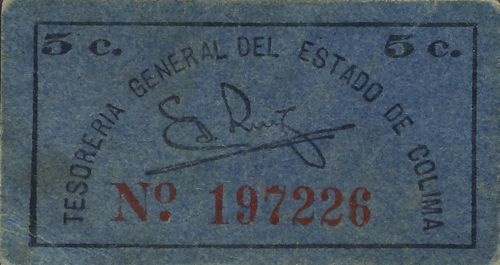
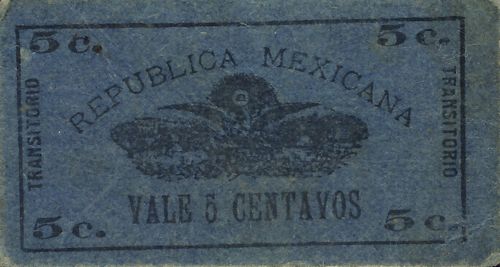 M1218 5c Tesorería General del Estado
M1218 5c Tesorería General del Estado
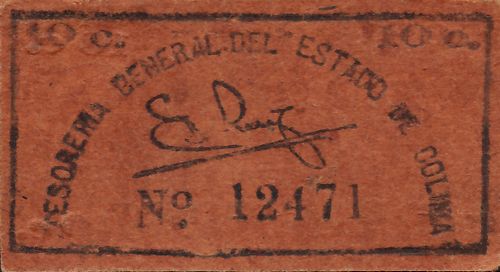
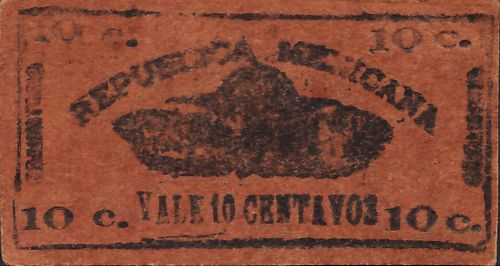 M1219 10c Tesorería General del Estado
M1219 10c Tesorería General del Estado

 M1201 20c Tesorería Gral. del Estado
M1201 20c Tesorería Gral. del Estado
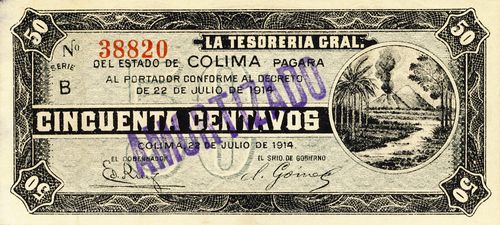
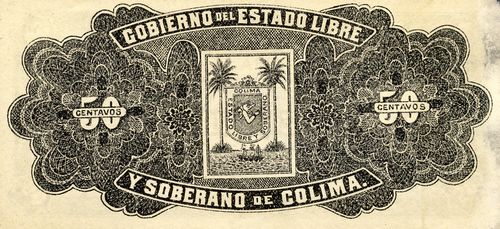 M1202b 50c Tesorería Gral. del Estado
M1202b 50c Tesorería Gral. del Estado
| date on note | series | from | to | total number |
total value |
||
| 5c | 1 | 100000 | 100,000 | $ 5,000 | includes numbers 6657 to 93404CNBanxico #169 | ||
| 10c | 1 | 50000 | 50,000 | 5,000 | includes numbers 10886CNBanxico #170 to 26016 | ||
| 20c | 22 July 1914 | A | 1 | 50000 | 50,000 | 10,000 | includes numbers 8499CNBanxico #10228 to 24371CNBanxico #145 |
| B | 1 | 50000 | 50,000 | 10,000 | includes numbers 34733 to 39456CNBanxico #10229 | ||
| 50c | A | 1 | 20000 | 20,000 | 10,000 | includes numbers 2056CNBanxico #10230 to 8666CNBanxico #150 | |
| B | 1 | 40000 | 40,000 | 20,000 | includes numbers 21918 to 38822CNBanxico #10231 | ||
| $60,000$30,000 and $20,000 authorised but $60,000 actually issued (CEHM, Fondo XXI-4 telegram Juan José Ríos, Colima, to Carranza, Veracruz, 6 September 1915). The proposed reconstruction assumes that the second issue was series B, though the decree called for all four denominations |
The two pasteboards have Governor Ruiz’ signature whilst the two higher values carry the signatures of Ruiz and Arturo Gómez as Secretary and another view, but this time of both Vólcan de Colima and the extinct Nevado de Colima.
|
Eduardo Ruiz was born in Guaymas, Sonora on 31 October 1879. On the orders of Alvaro Obregón he took Colima and drove out Delgadillo and Carranza promoted him to Teniente Coronel and named him governor and military commander on 21 July 1914. |
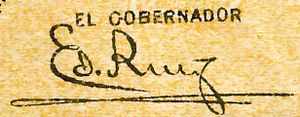 |
|
He joined the Maderistas at the Hacienda of El Alpuyeque before they took over the state capital in 1911. He was jefe político del Centro under the government of José Trinidad Alamillo. He was a federal deputy in the XXVI Legislature of Congress until it was dissolved by Victoriano Huerta on 10 October 1913. With the triumph of Constitutionalism in 1914 he was appointed Secretary of the Government and Military Command with the rank of major. Later, he was President of the Supreme Court of Justice in the state of Colima. In 1918 he was a candidate for senator but lost although he managed to win the following election in 1920. In 1934 he was a federal deputy in the XXXVI Legislature and retired as Head of Lawyers at the Federal Conciliation and Arbitration Board. |
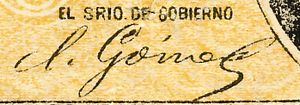 |
These were intended to circulate for just six months, but on 23 September Ruiz had to order a second issue of another 30,000 pesosEl Estado de Colima, Tomo XLVIII, Núm. 36, 26 September 1914.
Cartones
A local newspaper reported that the fractional notes of the state government were put into circulation on 4 September 1914El Popular, Epoca Tercera, Núm. 46, Colima, 5 September 1914. So this might be where to place an issue of 5c and 10c cartones. These will have been printed by the Guadalajara company of Litografía J. M. Iguíniz. Iguíniz produced similar perforated notes for the state of Jalisco in June 1914.
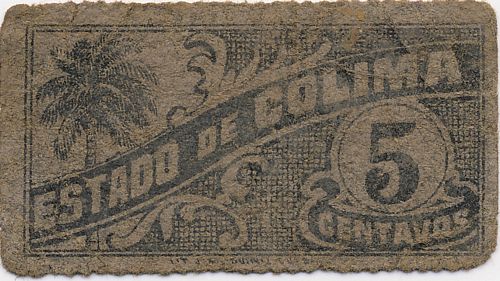
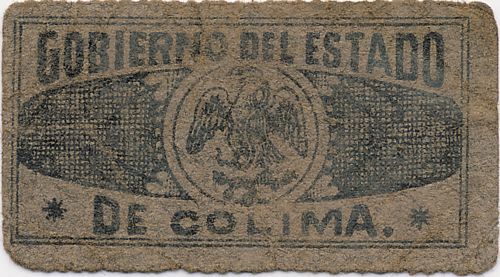 M1218 5c Gobierno del Estado
M1218 5c Gobierno del Estado
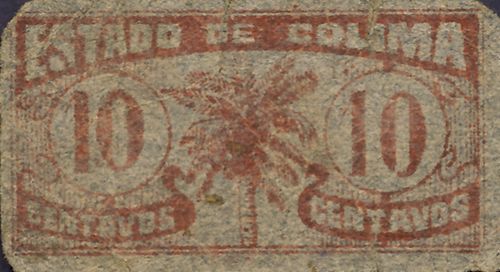
 M1219 10c Gobierno del Estado
M1219 10c Gobierno del Estado
| date on note | series | from | to | total number |
total value |
||
| 5c | |||||||
| 10c |
On 30 September Marcelino Cedano was paid thirty pesos for bringing bonos del Estado from GuadalajaraAHEC, leg. 847, 1914. In late August Cedano had been commissioned by the Jefe de Hacienda to oversee the printing of these bonos in the workshops of Juan KaiserAHEC, leg. 851, 1914.
On 5 November 1914 Dámaso B. Guillén was commissioned to take to the Jefatura de Hacienda in Guadalajara useless notes (billetes y bonos) to be exchanged, as well to collect in the Pagaduría General de la División de Occidente what the 1er. Batallón de Colima owed to the TesoreríaAHEC, leg. 871, 1915, exp. 9. Guillén later claimed 17 days’ expensesAHEC, leg. 871, 1915, exp. 3.
Issue of 18 January 1915
The currency problems continued and on 18 January 1915 the new provisional governor, Juan José Ríos, issued his decree núm. 7. Strangely his preamble states that difficulties had been caused to businesses and individuals by the lack of fractional paper currency, which had been taken out of the state. Anyway, given that the State Treasury had borrowed sufficient funds to back a new issue, he authorized an issue of 50,000 pesos in five denominations – 5, 10, 20 and 50 centavos and one peso. The notes issued would be redeemable after six months.
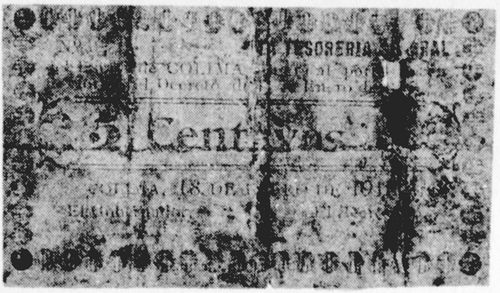 M1204 5c Tesorería General del Estado
M1204 5c Tesorería General del Estado
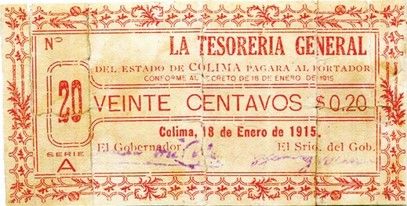
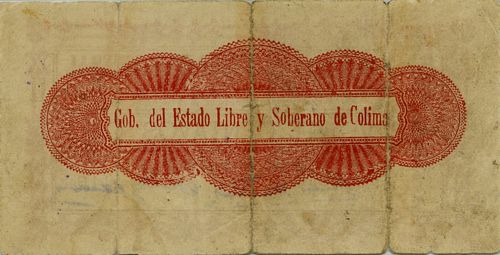 M1206 20c Tesorería General del Estado
M1206 20c Tesorería General del Estado
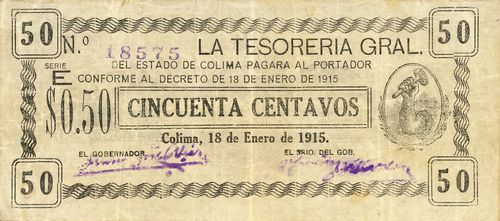
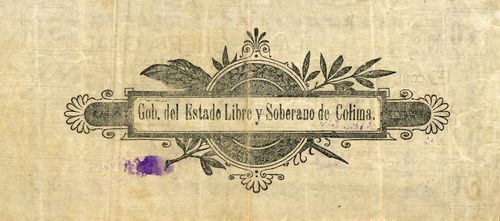 M1207 50c Tesorería General del Estado
M1207 50c Tesorería General del Estado
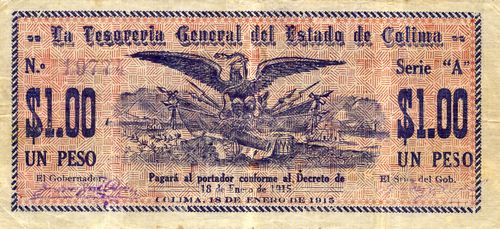
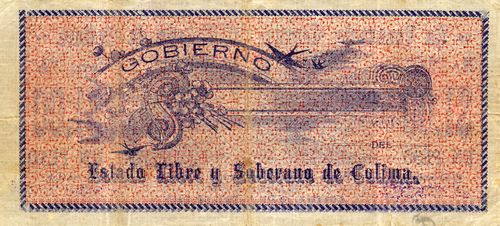 M1208a $1 Tesorería General del Estado
M1208a $1 Tesorería General del Estado
| date on note | series | from | to | total number |
total value |
||
| 5c | 18 January 1915 | ||||||
| 10c | |||||||
| 20c | A | includes number 3652CNBanxico #10232 | |||||
| 50c | A | includes number 6646CNBanxico #10233 | |||||
| C | |||||||
| E | includes number 18575 | ||||||
| $1 | A | includes numbers 232 to 19774 | |||||
| $50,000 |
At their meeting on 12 May 1915 the town council received a letter from the Administrador del Timbre who stated that he always tried to ease the difficulties of the state’s bonos and that it was not exact to say that his offices was refusing to accept themAMCol, Actas de Cabildo, Colima, libro 88, acta 65, fojas 5v-9f.
Counterfeits
On 27 August Ríos commented that people were refusing to accept these notes because of their deterioration, and also because they had discovered counterfeits of the issue. So they were to be replaced.
Issue of 15 June 1915
Another decree of 4 June 1915[text needed] authorized a new issue of 80,000 pesos.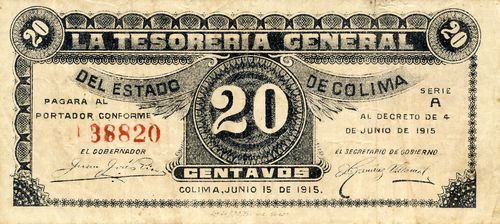
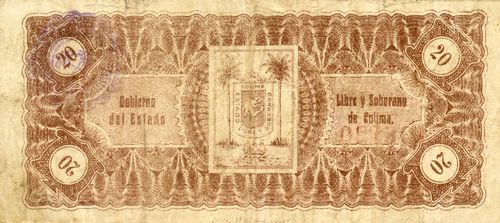 M1210 20c Tesorería General del Estado
M1210 20c Tesorería General del Estado
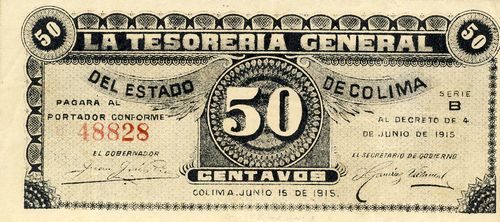
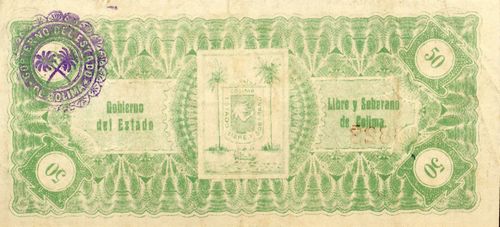 M1211 50c Tesorería General del Estado
M1211 50c Tesorería General del Estado
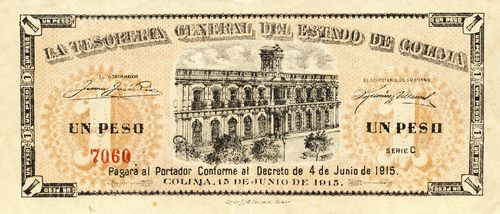
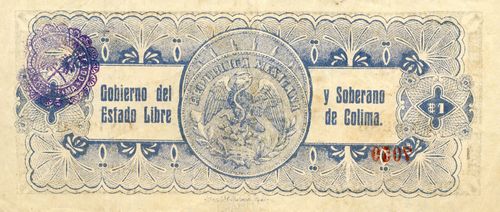 M1212 $1 Tesorería General del Estado
M1212 $1 Tesorería General del Estado
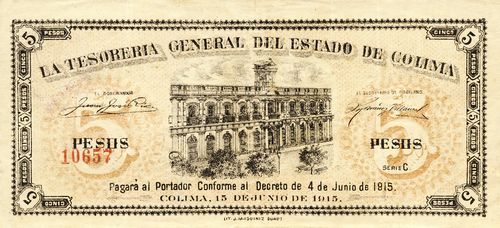
 M1213 $5 Tesorería General del Estado
M1213 $5 Tesorería General del Estado
| date on note | series | from | to | total number |
total value |
||
| 20c | 15 June 1915 | A | includes numbers 9884CNBanxico #146 to 40661CNBanxico #149 | ||||
| 50c | B | includes numbers 3934CNBanxico #10237 to 48871CNBanxico #151 | |||||
| $1 | C | includes numbers 2225CNBanxico #157 to 28127 | |||||
| $5 | C | includes numbers 678CNBanxico #10239 to 10657 | |||||
| $130,000 |
These were produced by the printing house Litografía J. M. Iguíniz, in Guadalajara, Jalisco. The higher values are signed by Juan José Ríos as Governor and Francisco Ramírez Villarreal, as Secretary
|
Released under Madero he was a crusading journalist on the Diario del Hogar, then helped form a workers’ union in Sonora. When Huerta usurped the presidency he joined the rebels in Sonora and formed the 2o Batallón de Cananea (later the 14o Batallón de Sonora). He fought in Sinaloa and Jalisco. He took over the governorship of Colima on 15 November 1914. Three days later he stepped down temporarily but resumed again on 6 January 1915, then left again for various military campaigns before resuming on 10 May 1915 and holding the governorship until 30 June 1917. He was Carranza’s Secretary of War (1917-20), then Director of the Colegio Militar (1927-1928), and Jefe del Estado Mayor and Secretario de Gobernación for Pascual Ortiz Rubio. He fought for Calles against the Cristeros, and in 1938 arbitrated between Bolivia and Paraguay in the Chaco War. He died in Culiacán, Sinaloa, on 18 April 1955. |
 |
|
He joined the Constitucionalists in 1913 and was a member of Manuel M. Diegúez' staff. In Colima he founded the newspaper El Baluarte. A career public servant, he was Secretario General of Colima in 1916 and three times interim Governor in 1916 and 1920. He was a member of the Constituent Congress in 1917, Secretario General of Nayarit from April to December 1917, President of the Superior Tribunal of Justice in Tamaulipas in 1921, Oficial Mayor of Nuevo León, Director General of the Diario Oficial in Mexico City from 1932 to 1934, and held several government posts, including Secretario de Gobernación, in 1934 and 1935. He died on 16 January 1982. |
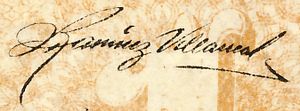 |
and the one and five peso notes have a view of the Government Palace with its distinctive clock tower.
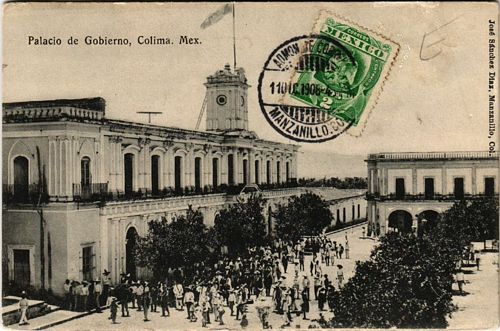
Demonetization and withdrawal
On 27 August Ríos commented that because people were refusing to accept the notes of the January issue because of their deterioration, and also because they had discovered counterfeits of this issue, they were to be replaced but with an equal amount. He therefore increased the 4 June 1915 issue by $50,000 to a total of $130,000. The exchange was to take place in the General Treasury up to 30 September. The Municipal Treasuries in the rest of the state could also collect notes, give a receipt and forward them to the central office. After 30 September the notes would be demonetized and holders would have no claim. On 1 September the Presidente Municipal decided that notes of the 18 January issue in the Tesorería Municipal that had deteriorated and become unusable should be exchanged in the Tesorería General de Estado with the special commissionerAMCol, 61, exp. 1 letter Presidente Municipal to Tesorero, 1 September 1915. However, as usual, because poorer people and those outside the main centres were unable to hand in their notes in time, on 1 October the period was extended for a month, though these 18 January notes were now no longer legal tenderAMCol, 61, exp. 1. On 27 October the presidente municipal of Colima wrote to the Secretario de Gobierno asking to exchange the large number of bonos of ex-Governor Ruiz, which were in too bad a state to circulate (as well as those of Delgadillo that still had not been exchanged). Three days later the Governor agreedAMCol, E-60ª, Pos 74, exp. 275.
On 6 September Riós had told Carranza that Ruiz’ two issues, though authorised for $50,000, in fact, according to records, totalled $60,000. The notes had not been amortized after six months, as decreed, were now in poor condition and stores were refusing them and they were mainly in the hands of the poor. As Riós did not have the funds to redeem them and they had been spent on military matters, he felt they were a federal, rather than a state, obligationCEHM, Fondo XXI-4 telegram Juan José Ríos, Colima, Colima to Venustiano Carranza, Veracruz, 6 September 1915.
Finally, in 1916 the other remaining issues were gradually withdrawn. On 17 April Ríos announced a period of two months for the handing in of the notes issued in accordance with Ruiz’ decrees of 22 July and 23 September 1914 to the Administración Principal de Rentas del Estado, though it seems that he reserved giving legal tender notes in exchange until his administration had discovered what had happened to the funds that were supposed to guarantee these issues. On 3 May Ríos ordered the withdrawal of the 4 June and 27 August issues: these were declared no longer of obligatory acceptance but until 25 May the General Treasury would exchange them for Gobierno Provisional notes issued in Veracruz. Thereafter they would be deemed worthless.
Rios questioned his predecessor Eduardo Ruiz' management as governor, especially in financial matters, and in May 1916, staged a public controversy by initiating an investigation into the fate of the public funds raised through Ruiz’ issue. Ruiz’ response was that he was “the one who craves this research the most because it would place men in their true position and definitively clarify the facts"Boletín Militar, Jalisco, 6 May 1916.
During the governorships of Ruiz and Ríos quantities of decommissioned paper money were collected and burnt in the patios of the Palacio de Gobierno.

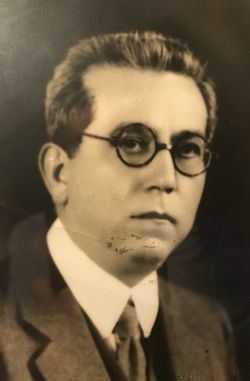 Arturo Gómez Mancilla was born in Colima and graduated as a lawyer in Mexico City in 1900. He worked in the Military Public Prosecutor's Office in Guadalajara and was editor of the Periódico Oficial of Jalisco and of the weekly La Gaceta de Guadalajara.
Arturo Gómez Mancilla was born in Colima and graduated as a lawyer in Mexico City in 1900. He worked in the Military Public Prosecutor's Office in Guadalajara and was editor of the Periódico Oficial of Jalisco and of the weekly La Gaceta de Guadalajara.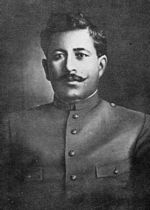 Juan José Ríos Ríos was born in San Luis Mezquital, Zacatecas on 27 December 1882. In his youth he campaigned against the Porfirian government, took part, with
Juan José Ríos Ríos was born in San Luis Mezquital, Zacatecas on 27 December 1882. In his youth he campaigned against the Porfirian government, took part, with 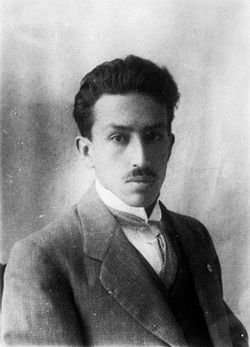 Francisco Ramírez Villarreal was born in Saltillo, Coahuila on 23 February 1890 and gained a law decree.
Francisco Ramírez Villarreal was born in Saltillo, Coahuila on 23 February 1890 and gained a law decree.